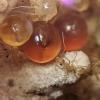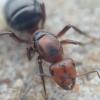- Formiculture.com
- Forums
- Gallery
- Members
- Member Map
- Chat

How destructive are Asian needle ants?
Started By
ANTdrew
, Sep 15 2021 1:39 PM
3 replies to this topic
#1
 Offline
-
Posted September 15 2021 - 1:39 PM
Offline
-
Posted September 15 2021 - 1:39 PM
This is the first season I’ve spotted a few workers in my compost bin and what I think were some queens at my blacklight. Will they wipe out my local diversity, or can natives hold their own against them? Looking for insights from folks further south with more experience with them.
- KadinB and Moonant01 like this
"The ants are a people not strong, yet they prepare their meat in the summer." Prov. 30:25
Keep ordinary ants in extraordinary ways.
Keep ordinary ants in extraordinary ways.
#2
 Offline
-
Posted September 15 2021 - 1:59 PM
Offline
-
Posted September 15 2021 - 1:59 PM
I have no personal experience with them, but this article has me worried about their potential to harm native species: https://entomology.ces.ncsu.edu/asian-needle-ant/
"This species is an unusual pest because unlike pest ants such as the fire ant and Argentine ant associated with places that have been disturbed by human activity, the Asian needle ant is able to nest in both disturbed and 'natural' areas like forests."
Edited by TestSubjectOne, September 15 2021 - 1:59 PM.
TestSubjectOne's Experiences in Antkeeping General Journal
Currently Keeping:
- Veromessor pergandei (1 queen, 600 workers)
- Novomessor cockerelli (1 queen, 200 workers)
- Myrmecocystus mexicanus (1 queen, 100 workers)
- Brachymyrmex patagonicus (3 queens?, 2,000 workers? & alates)
- Crematogaster sp. (1 queen, 600 workers)
- Liometopum occidentale (1 queen, 800 workers)
- Camponotus absqualator (1 queen, 130 workers)
#3
 Offline
-
Posted September 15 2021 - 2:21 PM
Offline
-
Posted September 15 2021 - 2:21 PM
Yes, this is mostly true. I have observed Brachyponera chinensis' ability to survive in almost completely undisturbed locations, finding several nests at Land Between the Lakes in Kentucky. That said, the colonies were small, and did not appear to be affecting the local biodiversity whatsoever. Their primary diet is termites, and the while location had an abundance of termites, it also was home to many other native species which I have observed to frequently prey on termites. It is also typically harder in general for exotic species to penetrate pristine environments and exploit a niche that is already filled by native species. The biggest threat, in my opinion, is areas that are lightly to moderately disturbed, where the invasive species can build up a population in the more disturbed sections before possibly spreading into nearby less disturbed areas. I believe this was what we observed in Kentucky, as the only colonies we noticed were along a "service road" (more like a set of tire tracks through a forest than anything). That said, the habitat in that location seemed to be fairly unique and we actually observed the most number of species in that one area than anywhere else we looked in the preserve.
I do believe that in areas where B. chinensis are able to get a foothold and establish large colonies, they can be extremely detrimental to local ant communities. However, I also believe their claimed ability to survive in "natural areas" is a bit overblown, as it seems to be more like they have the ability to only survive, not "dominate."
I may be incorrect in my assumption, as I have heard of localities further south than KY that have nearly homogenous B. chinensis populations despite the areas being "natural". However, I also find the Eastern US' idea of "natural" to be relatively skewed due to a much more concentrated human and agricultural presence. The Eastern US also has a plethora of invasive plant species, many of which originated in Asia, that may assist B. chinensis in inhabiting forests that those plants have already penetrated. This is mostly a theory, as I have only observed B. chinensis in the wild on one occasion, but based on the location and the status of the invasive colonies (being typically small, inactive, and not particularly widespread) leads me to believe that in areas which are truly undisturbed the species still struggles to establish a meaningful presence.
- ANTdrew, Manitobant, Somethinghmm and 4 others like this
#4
 Offline
-
Posted December 23 2021 - 7:37 PM
Offline
-
Posted December 23 2021 - 7:37 PM
I don't know how much insight this can offer, but if my memory of a single event from over 2 years ago serves, I think sort of yes and no. The only anecdote I have about them is from when I was visiting a small forest preserve near the beach in North Carolina. The area outside the forest had the standard ants for the area (largely S. invicta but there were others as well). Inside that forest, the ground was blanketed with B. chinensis. But interestingly, those same woods also held some Trachymyrmex septentrionalis. I'm not very knowledgeable about T. septentrionalis, but I'd imagine they're not the most hardy against invasives. My best guess is that it's because they don't compete for the same resources as B. chinensis.
- ANTdrew and Antkeeper01 like this
0 user(s) are reading this topic
0 members, 0 guests, 0 anonymous users
















